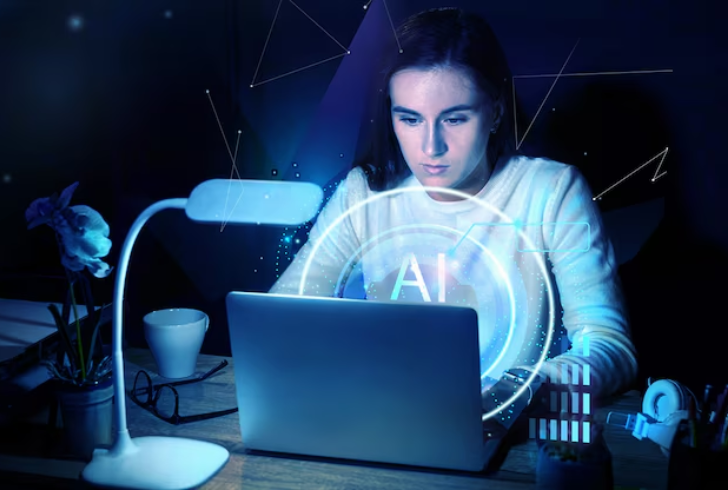7 Scientific Findings on How AI Impacts Human Behavior
Artificial intelligence isn’t just powering search engines and smart assistants anymore—it’s becoming a mirror, reflecting and sometimes reshaping the way humans think, act, and make decisions. As tools like ChatGPT and other large language models grow more embedded in daily tasks—from diagnosing health conditions to writing resumes—scientists are uncovering what this interaction really means for the human mind.
Recent studies are revealing how AI is influencing everything from political leanings to workplace dynamics, and even how people drive or think critically.
Here’s a closer look at seven recent findings that explore AI’s deeper psychological, social, and behavioral impact.
1. AI Red Teaming

Freepik | Exploring AI stress responses, a PLOS One study highlights “red teaming” by a diverse group of testers.
A recent study in “PLOS One” dives into the lesser-known practice of “red teaming” AI. But these aren’t hackers in the typical sense. Instead, they’re curious minds—software developers, artists, and enthusiasts—testing large language models to better understand how they respond under pressure.
Rather than aiming to break systems, these testers explore AI behavior through creative prompts and scenarios. Their methods include strategies like:
– Roleplaying and fictional storytelling
– Layered questioning and misleading logic
– Provocative or rule-challenging language
These approaches resemble psychological probing more than traditional hacking. One participant described the experience as “feeling like staring into a crystal ball,” highlighting the unpredictable nature of the outcomes. The research emphasizes the need for a more human-focused method in testing AI, especially when traditional security tools fall short.
2. AI’s Political Bias
Research published in “Humanities & Social Sciences Communications” tested the political tone of ChatGPT-3.5 versus GPT-4, using the Political Compass Test. Both versions showed a lean toward libertarian-left ideology, but GPT-4 edged closer to center-right economic values.
This shift wasn’t attributed to obvious changes in training material. Instead, researchers suggest it might stem from slight alterations in how the model interprets or prioritizes responses.
Since these tools are increasingly used in education and public communication, tracking such shifts becomes important, not because the models “believe” anything, but because their responses influence users.
3. ChatGPT Scores Big in Psychiatry Vignettes

Pexels | Matheus Bertelli | Research showed ChatGPT 3.5 to be highly accurate in diagnosing psychiatric cases, rarely erring.
In a study published in the “Asian Journal of Psychiatry,” ChatGPT 3.5 was put to the test with 100 psychiatric case vignettes. The results were startling. It achieved the highest diagnostic grade in 61% of the cases and came second in 31%—with zero outright diagnostic mistakes.
Each case was structured with detailed symptom descriptions, and experienced psychiatrists reviewed the model’s responses. The most impressive part? The model’s ability to form effective treatment strategies rather than just identify conditions.
This raises questions about the future of AI-assisted clinical support in mental health, though caution is still needed when applying these tools beyond well-structured datasets.
4. Workplace Inequality and AI Adoption
In a wide-ranging study involving 18,000 Danish workers, researchers found that AI tools like ChatGPT are deepening workplace divides. Younger, higher-income men were far more likely to adopt AI tools, especially in fields such as software development and journalism.
Meanwhile, women and lower-income workers were less likely to engage with AI, even when doing similar jobs. Key barriers included a lack of training and unclear policies from employers. Those who did adopt AI tools tended to report higher productivity and optimism, suggesting that unequal access could lead to long-term skill and income disparities.
5. AI Detects Depression Through Driving Patterns
Researchers at Washington University in St. Louis linked driving behavior to signs of depression in older adults. Using GPS data over two years, the study analyzed driving habits such as:
– Frequency of hard braking
– Unusual route changes
– Increased mileage without clear patterns
Older adults with signs of depression displayed more erratic driving, even when standard cognitive tests showed no major differences. The AI model, when combined with data on medication use, could detect depression with up to 90% accuracy. This suggests that real-world behavior, not just clinical settings, may hold important clues about mental health.
6. Over-Reliance on AI Could Weaken Human Critical Thinking

Freepik | AI dependence may reduce critical thinking skills through cognitive offloading.
In a study published in “Societies,” researchers examined how people’s reliance on AI tools impacts critical thinking. It turns out that when users let AI handle problem-solving, they’re more likely to skip deeper thinking processes—a behavior known as cognitive offloading.
The trend was strongest in younger users. However, people with more formal education seemed to resist this effect better, possibly due to ingrained habits of analysis and skepticism. These results point to the need for balance—AI can offer convenience, but overuse may lead to a drop in core thinking skills.
7. Language Models Try to “Look Good” in Personality Tests
When large language models were asked questions from the Big Five personality test, researchers noticed a consistent trend: They tried to give socially desirable answers. The models leaned toward portraying themselves as friendly, emotionally stable, and diligent.
Interestingly, the longer the test session, the more this effect increased. Researchers believe the models adjust their answers mid-session to maintain a positive image, even when questions are rephrased or shuffled. This behavior matters when AI is used in psychological evaluations, as the data it provides may be skewed toward what seems “ideal” rather than what’s realistic.
AI Is Changing More Than Tasks
Artificial intelligence is no longer just a tool in the background—it’s actively influencing thoughts, behaviors, and even social systems. From healthcare to politics, and from driving habits to job equity, AI is touching nearly every part of life.
These new studies underscore the importance of developing smarter technology and ensuring it aligns with human needs, values, and fairness.
As artificial intelligence becomes more embedded in everyday life, staying aware of how it affects human psychology and behavior will be key, not just for developers and researchers, but for everyone who interacts with it.